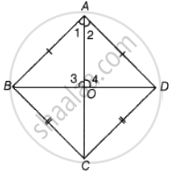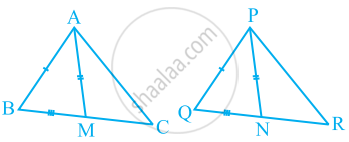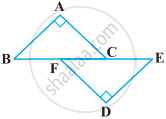Advertisements
Advertisements
प्रश्न
ABC and DBC are two triangles on the same base BC such that A and D lie on the opposite sides of BC, AB = AC and DB = DC. Show that AD is the perpendicular bisector of BC.
उत्तर
Given in the question, ABC and DBC are two triangles on the same base BC such that A and D lie on the opposite sides of BC, AB = AC and DB = DC.

To proof that AD is the perpendicular bisector of BC that is OB = OC.
Proof: In triangle BAD and triangle CAD,
AB = AC ...[Given]
BD = CD ...[Given]
AD = AD ...[Common side]
Now, by SSS criterion of congruence,
ΔBAD ≅ ΔCAD
So, ∠1 = ∠2 ...[CPCT]
Now, in triangle BAO and triangle CAO,
AB = AC ...[Given]
∠1 = ∠2 ...[Proved above]
AO = AO ...[Common side]
So, by SAS criterion of congruence,
ΔBAO ≅ ΔCAO
Since, BO = CO ...[CPCT]
And ∠3 = ∠4 ...[CPCT]
∠3 + ∠4 = 180° ...[Linear pair axiom]
∠3 + ∠3 = 180°
2∠3 = 180°
∠3 = `(180^circ)/2`
∠3 = 90°
Therefore, AD is perpendicular to bisector of BC.
Hence proved.
APPEARS IN
संबंधित प्रश्न
Two sides AB and BC and median AM of one triangle ABC are respectively equal to sides PQ and QR and median PN of ΔPQR (see the given figure). Show that:
- ΔABM ≅ ΔPQN
- ΔABC ≅ ΔPQR

Prove that in a quadrilateral the sum of all the sides is greater than the sum of its diagonals.
In the following figure, BA ⊥ AC, DE ⊥ DF such that BA = DE and BF = EC. Show that ∆ABC ≅ ∆DEF.

ABC is an isosceles triangle in which AC = BC. AD and BE are respectively two altitudes to sides BC and AC. Prove that AE = BD.
Prove that sum of any two sides of a triangle is greater than twice the median with respect to the third side.
In a right triangle, prove that the line-segment joining the mid-point of the hypotenuse to the opposite vertex is half the hypotenuse.
Two lines l and m intersect at the point O and P is a point on a line n passing through the point O such that P is equidistant from l and m. Prove that n is the bisector of the angle formed by l and m.
Line segment joining the mid-points M and N of parallel sides AB and DC, respectively of a trapezium ABCD is perpendicular to both the sides AB and DC. Prove that AD = BC.
ABC is a right triangle such that AB = AC and bisector of angle C intersects the side AB at D. Prove that AC + AD = BC.
ABCD is quadrilateral such that AB = AD and CB = CD. Prove that AC is the perpendicular bisector of BD.
